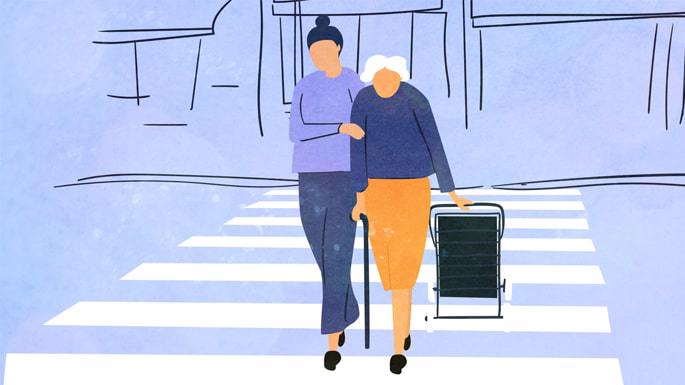I recently attended a talk given by a prominent speaker at a Jewish elementary school. The thesis of the talk was that when people refer to mundane actions as mitzvot, they are speaking imprecisely. It is true, he conceded, that something like helping an elderly person cross the street might be a nice thing to do. It might even seem as if it should be a mitzvah—one of the 613 commandments communicated by G‑d to the Jewish People at Sinai. But is it in the Torah? Is it codified in Jewish law?
Since the answers to these questions are both negative, the speaker concluded, we must resist the temptation to conflate “good deeds” with mitzvot. In fact, he argued, such conflation is a symptom of an insidious trend that accords less authority to our holy texts and more to subjective feel-good morality that derives from external cultural trends.
Could it be true, I wondered, that there really is no mitzvah to help people? I tried to consider how what I already knew (or thought I knew) fit in with the speaker’s narrative.
An initial survey of the literature does yield disappointing results. There is no verse in the Torah that discusses elderly people crossing streets. Not only that, but browsing medieval “mitzvah counting” literature likewise does not lead to an entry such as “Mitzvah 50: Help an elderly person safely cross the street.” (Counting the mitzvot was a popular activity among medieval rabbis. Although all agreed that there are 613 in total, there was some disagreement about precisely which mitzvot count, which are subsumed under the headings of other mitzvot, which are statutes instituted by the rabbis, etc.)
So, is that it? Does the absence of an explicit reference to helping an elderly person cross the street constitute the proverbial nail in the coffin of the possibility that it might in fact be a “real” mitzvah? Is it indeed the case that my previous assumption was truly derived from a modern innovation, with no source in the classic texts that authoritatively establish what is and is not included in the 613 mitzvot of the Torah?
As it turns out, a more careful reading of the relevant sources yields an entirely different picture. To begin with, a number of important medieval authorities, including Maimonides, count the Torah’s injunction to “walk in His ways” as a mitzvah:
Mitzvah eight is that we have been commanded to emulate Him (may He be exalted) to the best of our ability … just as the Holy One blessed be He is called gracious, so too you must be gracious; just as He is called merciful, so too you must be merciful; just as He is called pious, so too you must be pious.1
Helping an elderly person cross the street safely—an act that involves graciousness and mercy—clearly qualifies.
But the fact that helping an elderly person across the street fulfills one mitzvah does not mean we should stop there. The Mishnah features a fascinating hypothetical about a single action that entails the transgression of the greatest possible number of commandments (a kohen who is also a nazir plows a graveyard on a holiday during a shemitah year, violating eight commandments at the same time).2 Just as it is possible to commit many transgressions with one act, it is possible to fulfill many mitzvot with one act.
There are, in fact, a number of additional commandments which can be fulfilled by helping an elderly person to cross the street, including, “Stand up before the white-haired and respect an elder.”3 This is interpreted by the Sages as a commandment to respect Torah scholars. The Talmud quotes Issi ben Yehuda who interprets the verse to mean that even elderly people who are not learned must be honored,4 and Maimonides rules accordingly:
We should stand before an old person of exceedingly advanced age, even if he is not a sage. Even a sage who is young should stand before an old person of exceedingly advanced age … Even an old gentile should be addressed with words of respect, and a hand should be extended to support him, as [the Torah states], “Stand up before the white-haired.” Every white-haired person is included therein.5
As several commentators observe, this obviously applies equally to both elderly men and elderly women.6 We can safely assume, therefore, that extending a hand to support any elderly person is a fulfillment of the mitzvah to “stand up before the white-haired.”
Also relevant is the mitzvah to love one’s fellow Jew:
Mitzvah 206 is that we are commanded to love each other as we love ourselves, and that his love and his mercy for his brother should be like his love and mercy for himself, with his money and with his body and all that is within his domain. If he desires it [for himself] I should desire it [for him], and all that I desire for myself I shall desire for him likewise. And this is what He (may He be exalted) said: “And you shall love your brother as yourself.”7
This commandment clearly includes using our bodies to help the elderly cross the street, just as we would hope that others would help us if we needed help crossing the street.
Furthermore, there is an additional commandment–the parameters of which are very similar to those pertaining to loving one’s fellow Jew–to love the convert (Maimonides counts it as the 208th commandment). Therefore, if the elderly person in question is a convert to Judaism, one would be fulfilling an additional commandment in the act of helping him or her across the street.
Finally, we are commanded to honor our parents (mitzvah 210),8 so if the elderly person is also one’s mother or father, one would be fulfilling no less than five Torah commandments through this single act!
The above analysis shows that, depending on the status of the particular elderly person in question, helping him or her to cross the street would involve, according to Maimonides, a bare minimum of two mitzvot (if not Jewish) and up to a grand total of five mitzvot (and possibly more that I have missed) if he or she is your parent as well as a convert to Judaism.
So how was it possible for the speaker that I heard to classify such a mitzvah-heavy, holy action as purely secular and mundane?
Contemplating this question, the following story came to mind:
While on a journey, Rabbi Yosef Yitzchak Schneersohn, the sixth rebbe of Chabad, was sitting in a hotel lobby. He was approached by a Jew who asked him to explain what the Chassidic movement purported to be about. “Does Chassidism contribute something new? If so, how can such newness be consistent with the eternity of the immutable Torah?”
The Rebbe pointed toward the ceiling of the hotel lobby and made an observation about a detail in the mural that was painted there. He asked his interlocutor whether he had noticed the detail. When the latter impatiently replied that he hadn’t, the Rebbe explained that just as it is possible to overlook the finer details in a work of art, it was possible for people to overlook certain mitzvot in the Torah. Chassidism, however, shines a light on these fine details and “rediscovers” otherwise neglected mitzvot that had been there all along..
What were these neglected mitzvot? They include the theological commandments that some medieval authorities call “duties of the heart” and others categorize as “constant commandments,” since, unlike most other mitzvot, they are relevant at all times of day and night. These include non-ritualistic obligations such as “loving G‑d,” “fearing G‑d,” and “having faith in G‑d.”9
The Baal Shem Tov, founder of Chassidism, brought these commandments back to the forefront of Jewish life. But he was perhaps most well known for promoting the commandment to love one’s fellow Jew as oneself.
These old-new teachings might be thought of as what is nowadays called a “reality check.” Sometimes it is possible to become so intellectually involved in complicated narratives and sophisticated minutiae that we lose track of the relatively simple truths that have been there all along. A reality check gives us the perspective to acknowledge these fundamental facts, some of which might be even more important than the non-obvious trains of thought we might pursue in the course of sophisticated Torah study.
The Baal Shem Tov’s emphasis on the imperative to love one’s fellow is still alive and being passed on to the next generation today. At the Chassidic school where I work, the principal recently called for the kindergarteners’ attention during indoor recess to inform them that she had been impressed by “the sounds of ahavat Yisrael” (love for one’s fellow Jew) that she had heard coming from the auditorium while walking down the hallway. She rewarded each kindergartener with a pretty pencil and encouraged the class to continue practicing this mitzvah in the future. Instead of referring to what the girls had been doing with such vague English terms as “kindness” or “being nice,” their principal used a halachic term to label their actions. This discursive maneuver precisely reflects the fundamental teaching of the Baal Shem Tov: acts of love and kindness, such as sharing with one’s friends during recess or helping an elderly person to cross the street, are neither extra-halachic nor optional. They are mitzvot, part of the eternal legal core of Judaism.







Join the Discussion